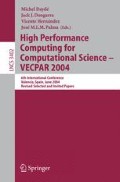Abstract
A parallel version of the Generalized Finite Element Method is applied to multiparticle problems. The main advantage of the method is that only a regular hexahedral grid is needed; the particles do not have to be meshed and are represented by special basis functions approximating the field behavior near the particles. A general-purpose parallel Schur complement solver with incomplete LU preconditioning (A. Basermann) showed excellent performance for the varying problem size, number of processors and number of particles. In fact, the scaling of the computational time with respect to the number of processors was slightly superlinear due to cache effects. Future research plans include parallel implementation of the new Flexible Local Approximation MEthod (FLAME) that incorporates desirable local approximating functions (e.g. dipole harmonics near particles) into the difference scheme.
Access this chapter
Tax calculation will be finalised at checkout
Purchases are for personal use only
Preview
Unable to display preview. Download preview PDF.
References
Babuška, I., Melenk, J.M.: The partition of unity method. Intl. J. for Numer. Methods in Engineering 40(4), 727–758 (1997)
Babuška, I., Caloz, G., Osborn, J.E.: Special finite-element methods for a class of 2nd-order elliptic problems with rough coefficients. SIAM Journal on Numerical Analysis 31(4), 945–981 (1994)
Basermann, A.: QMR and TFQMR methods for sparse non-symmetric problems on massively parallel systems. In: The Mathematics of Numerical Analysis, series: Lectures in Applied Mathematics, vol. 32, pp. 59–76 (1996)
Basermann, A.: Parallel Block ILUT/ILDLT Preconditioning for Sparse Eigenproblems and Sparse Linear Systems. Num Linear Algebra with Applications 7, 635–648 (2000)
Basermann, A., Jaekel, U., Hachiya, K.: Preconditioning parallel sparse iterative solvers for circuit simulation. In: Proceedings of The 8th SIAM Conference on Appl. Lin. Alg., Williamsburg, VA, USA (July 2003) http://www.siam.org/meetings/la03/proceedings/basermaa.pdf
Belytschko, T., et al.: Meshless methods: an overview and recent developments. Computer Methods in Applied Mechanics and Engineering 139(1-4), 3–47 (1996)
Duarte, C.A., Babuška, I., Oden, J.T.: Generalized finite element methods for three-dimensional structural mechanics problems. Computers & Structures 77(2), 215–232 (2000)
Freund, R.W., Nachtigal, N.M.: QMR: A quasi-minimal residual method for non-Hermitian linear systems. Numerische Mathematik 60, 315–339 (1991)
Grant, J.A., Pickup, B.T., Nicholls, A.: A smooth permittivity function for Poisson–Boltzmann solvation methods. J. Comp. Chem. 22(6), 608–640 (2001) (and references therein)
Griebel, M., Schweitzer, M.A.: A particle-partition of unity method for the solution of elliptic, parabolic and hyperbolic PDE. SIAM J. Sci. Comp. 22(3), 853–890 (2000)
Griebel, M., Schweitzer, M.A.: A particle-partition of unity method-Part II: efficient cover construction and reliable integration. SIAM J. Sci. Comp. 23(5), 1655–1682 (2002)
Griebel, M., Schweitzer, M.A.: A particle-partition of unity method-Part III: a multilevel solver. SIAM J. Sci. Comp. 24(2), 377–409 (2002)
Greengard, L., Rokhlin, V., Cheng, H.: A fast adaptive multipole algorithm in three dimensions. J. of Comp. Phys. 155(2), 468–498 (1999)
Melenk, J.M., Babuška, I.: The partition of unity finite element method: Basic theory and applications. Comput. Methods Appl. Mech. Engrg. 139, 289–314 (1996)
Müller, W.: Comparison of different methods of force calculation. IEEE Trans. Magn. 25(2), 1058–1061 (1990)
Plaks, A., Tsukerman, I., Friedman, G., Yellen, B.: Generalized Finite Element Method for magnetized nanoparticles. IEEE Trans. Magn. 39(3), 1436–1439 (2003)
Proekt, L., Tsukerman, I.: Method of overlapping patches for electromagnetic computation. IEEE Trans. Magn. 38(2), 741–744 (2002)
Saad, Y.: Iterative Methods for Sparse Linear Systems, 2nd edn. SIAM, Philadelphia (2003)
Saad, Y., Sosonkina, M.: Distributed Schur complement techniques for general sparse linear systems. SISC 21, 1337–1356 (1999)
Strouboulis, T., Babuška, I., Copps, K.L.: The design and analysis of the Generalized Finite Element Method. Comp. Meth. in Appl. Mech. & Engrng. 181(1-3), 43–69 (2000)
Strouboulis, T., Copps, K., Babuska, I.: The generalized finite element method. Computer Methods in Applied Mech. and Engineering 190(32-33), 4081–4193 (2001)
Tsukerman, I., Proekt, L.: Generalized scalar and vector elements for electromagnetic computation. In: XI Intern Symposium on Theoretical Electr. Eng., Linz, Austria (August 2001)
Proekt, L., Yuferev, S., Tsukerman, I., Ida, N.: Method of overlapping patches for electromagnetic computation near imperfectly conducting cusps and edges. IEEE Trans. Magn. 38(2), 649–652 (2002)
Tsukerman, I.A.: Approximation of conservative fields and the element ‘edge shape matrix’. IEEE Trans. Magn. 34, 3248–3251 (1998)
Tsukerman, I.A., Plaks, A.: Comparison of accuracy criteria for approximation of conservative fields on tetrahedra. IEEE Trans. Magn. 34, 3252–3255 (1998)
Tsukerman, I.A.: Accurate computation of ‘ripple solutions’ on moving finite element meshes. IEEE Trans. Magn. 31(3), 1472–1475 (1995)
Tsukerman, I.: Flexible local approximation method for electro- and magnetostatics. IEEE Trans. Magn. 40(2), 941–944 (2004)
Van der Vorst, H.: Bi-CGSTAB: A fast and smoothly converging variant of Bi-CG for the solution of nonsymmetric linear systems. SIAM J. Sci. Statist. Comput. 13, 631–644 (1992)
Washio, T.: NEC Europe, private communication
Yellen, B.B., Friedman, G.: Programmable assembly of heterogeneous colloidal particles using magnetic micro-well templates. Langmuir 20, 2553–2559 (2004)
Author information
Authors and Affiliations
Editor information
Editors and Affiliations
Rights and permissions
Copyright information
© 2005 Springer-Verlag Berlin Heidelberg
About this paper
Cite this paper
Basermann, A., Tsukerman, I. (2005). Parallel Generalized Finite Element Method for Magnetic Multiparticle Problems. In: Daydé, M., Dongarra, J., Hernández, V., Palma, J.M.L.M. (eds) High Performance Computing for Computational Science - VECPAR 2004. VECPAR 2004. Lecture Notes in Computer Science, vol 3402. Springer, Berlin, Heidelberg. https://doi.org/10.1007/11403937_26
Download citation
DOI: https://doi.org/10.1007/11403937_26
Publisher Name: Springer, Berlin, Heidelberg
Print ISBN: 978-3-540-25424-9
Online ISBN: 978-3-540-31854-5
eBook Packages: Computer ScienceComputer Science (R0)

